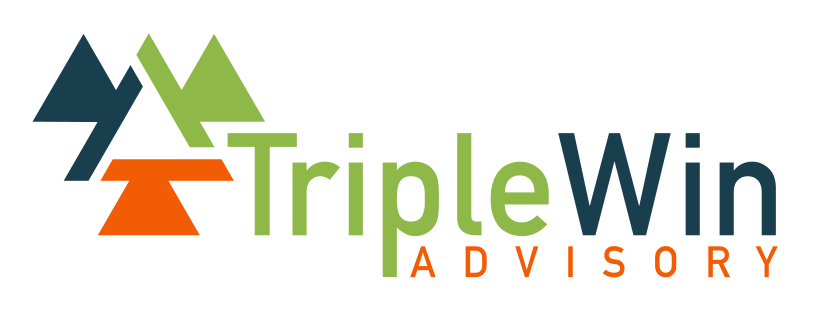I often say Corporate Sustainability is a journey. Yvon Chouinard, the founder of Patagonia didn’t start with a sustainable company in 1973. He progressed to it with the realization that his company’s impact on the environment was detrimental in its pursuit of creating useful goods for individuals to enjoy. His epiphany, that realization set his company’s sustainability journey in motion. Today, Patagonia’s “reason for being” translates into a one-sentence mission statement: “We’re in the business to save our home planet.” That was a journey a half-century in the making.
The True Business of Business
I want to make an overly obvious (some will say, ambitious) statement: “We are all in the business of saving our planet” whether we know it or believe it to be true. Our very existence depends on it. Asking others – scientists, policymakers, activists – to do the work we are all tasked to do and responsible for completing is a failure of conscious, a waste of capabilities, and a rejection of leadership.
Corporate sustainability requires big, heavy, systemic change. It can be both complicated and challenging to implement. The hardest part is often in deciphering how to answer, “Where to begin?” Some companies eager to begin, fail to identify where the finish line resides. Complicating matters more, no one-size-fits-all solution exists within and across industries.
Looked at from a particular angle, that should be a relief. Independent thinking and creating solution-setting remain valuable traits toward this endeavor.
Corporate Sustainability’s Need, Value and Imperative
What companies do need to understand is where they are presently and what they need to journey towards. Call that the path-forward. There are many frameworks and tools available to help organizations understand how to walk that path; to take the first foray into their sustainability journey. For many, it starts with writing a corporate sustainability report. For others, the push is to report their greenhouse gas (GHG) emissions. It’s worth stepping back for a moment though, to understand and put into context the need, value, and imperative of corporate sustainability.
The Need: to affect a fundamental transformation in how business is conducted to neutralize its impact on the planet’s eco-system in support of human communities.
The Value: these are numerous and include operational savings and efficiencies, cost reductions, new revenue models, distinct product differentiation, competitive advantage, and a host of beneficial employee and supplier productivity, longevity, and loyalty metrics to be realized.
The Imperative: to support a livable and healthful planet.
Within corporate sustainability’s Need, Value and Imperative matrix, we can explore four value-creation paradigms that are separate yet intertwined; each reinforcing the other to pull companies toward becoming proactively and implicitly inclusive, civil-minded, and eco-system restorative. Realize that most every organization will explore each of these journeys in time, at individual paces, and through unique mechanisms and means.
The Process of Sustainability Journeys
Let’s not forget the oft-quoted adage of Peter Drucker “what gets measured, gets improved.” As you walk through these value-creating mindsets, remember how corporate (sustainability) journeys are built:
- Assessment of the current state
- Definition of business goals
- Measurement of business risks & opportunities
- Prioritization of the doable, the impactful, and the business critical
- Development of an action plan
- Quantification of progress
- Review, analysis, and refinement of goals, performance metrics and action plans
- Iteration to reach the next level
Four Value-Creation Paradigms for Corporate Sustainability
I will discuss each of four value-creation paradigms separately. Ultimately, they fit together like four pieces of a puzzle. See them as four quadrants of a two-dimensional XY axes. By identifying where your organization is today within each quadrant, a 2-dimensional map can be drawn among them to understand where sustainability efforts are lagging or require additional attention. Note: each of these value sets often follow in tandem with the others. That is: if stakeholder engagement is low, an organization can likely find that there is low organizational embeddedness of material issues and organizational sustainability implementation is stubbornly stuck below non-strategic levels.
Paradigm 1: Level of Corporate Responsibility
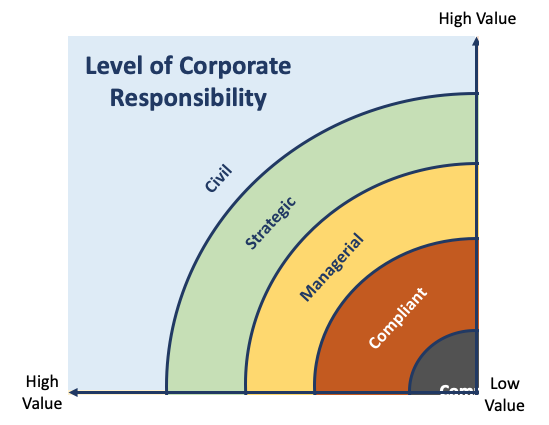
Assessing where a company is in its corporate sustainability journey is the appropriate right step before defining priority goals, stakeholder engagement and material issue embeddedness. Four corporate responsibility levels exist. The first and most rudimentary is Compliant. A company pursues corporate responsibility measures where it has to; where it must abide by the rules and regulations governing areas of operation. Think here: Environmental Health and Safety (EHS) compliance, Labor rights, Air Quality safety, and Health Insurance Portability and Accountability Act of 1996 (HIPAA) in Health Care. Compliant-level companies are pursuing bare-minimum corporate sustainability measures.
Managerial-level corporate sustainability implementation considers and engages the company’s stakeholders; making transparent their issues of concern within reporting documents, such as in a sustainability report. Strategic-minded companies proactively engage their key stakeholders, identify their key concerns, prioritize those into strategic business decision-making and actively address them through process modifications (e.g., non-dyeing and stone-washing with lasers in apparel making), product changes (e.g., substituting corn syrup with cane sugar in sodas), and/or policy, procedure and mission overhauls (e.g., change in women-athlete pregnancy policy). At the civil implementation level, companies have fully embedded a sustainability mindset internally, have met with success, and work as external change agents for their stakeholders – partners, suppliers, customers – persuading them to pursue the same or similar levels of sustainability within their business operations.
When you look at this quadrant, ask yourself:
“How does my company approach corporate sustainability today?”
Paradigm 2: Organizational Sustainability Implementation
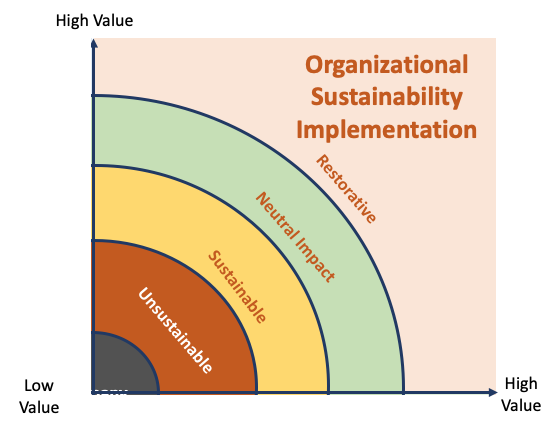
Existing companies run the gamut from operating Unsustainably to pursuing environmentally Restorative business goals. An organization that orients around having a Neutral Impact is one that is pursuing net zero carbon emissions goals across its value chain. Often, that type of goal is articulated as a RE100 goal: sourcing and utilizing 100% renewable energy by a certain timeframe (say, by 2030) across a company’s chain of business through a diverse strategy of say, on-site generation of solar or wind energy, carbon offsets and the purchase of renewable energy certificates. More and more Fortune 1000 businesses have declared this their organizations’ sustainability goal. Companies goal-orienting around “Restorative”, is to have organizations committed to pursuing net-positive carbon emission goals. Said another way: a company determines to capture and sequester carbon in their business operations, which entails going beyond achieving zero carbon emissions and seeking negative carbon emissions goals in its operations and in the products it manufactures.
When you look at this quadrant, ask yourself:
“What should my company’s sustainability goal(s) be?”
Paradigm 3: Responsiveness to Stakeholders
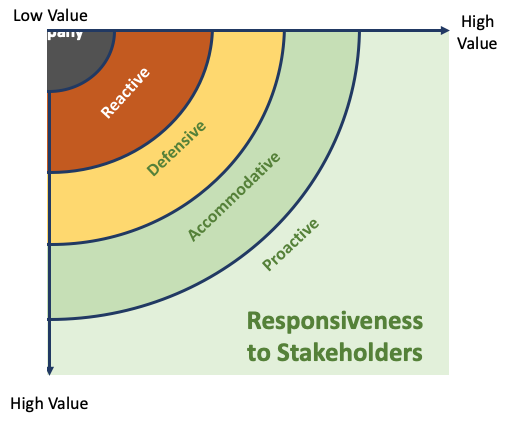
Corporate Sustainability and “Stakeholder Engagement” go hand-in-hand. Sustainable projects can be pursued. Sustainable reports can be written. Sustainable priorities can exist. But if a company has not gone out and conducted the work of identifying its key stakeholders, engaging them in communication feedback and soliciting their concerns as it relates to the organization’s operations, then a company has yet to truly understand the meaning of what corporate sustainability is. A company exists because of its stakeholders (the market of buyers), for its stakeholders (the suppliers and employees who keep operations running, investors), and in support of its stakeholders (productive workforce, healthy environment, strong economy).
So here goes: if an organization fails to consider its key stakeholders in the course of business, that company operates Reactively and unwittingly, in an extremely high-risk environment. Think: Volvo’s diesel-gate scandal, Facebook’s privacy scandal involving Cambridge Analytica, child labor scandals that have affected some of the largest apparel makers in the U.S. including The Gap and Nike, and of course, the Enron financial and accounting scandal of breath-taking proportion. All of these companies at the time their particular scandals hit, were operating with a Reactive Stakeholder mindset: they did not/were not/had not considered the issues of concern for their stakeholders and by doing so, breached their trust, caused considerable damage to their brands and reputations, lost a fair amount of value in their businesses, and in one case, ceased to exist.
Reactive companies once called-out, move quickly to Defensive-mode. Philip Morris (now Altria) has operated with this mindset from its very inception. It has long known that its products kill but the profits from those products are too enticing to give-up. Oil & Gas is an industry made up of Defensive companies. Exxon Mobil, Shell and the like absolutely know they directly contribute to accelerating global climate change. And while they offer modest, conciliatory overtures to pursue “clean” fuels, their corporate interests solidly lie in keeping their stakeholders on the cheap-train of fossil fuel use.
Companies that accommodate their stakeholders’ concerns have provided some channels of communication for interaction and accept feedback. The downside of an Accommodative approach is that lines of communication are not deliberate and stakeholder concerns fail to be incorporated into the strategic business decision-making of organizations. A Proactive stakeholder engagement strategy is an active, ongoing and deliberate action plan for identifying and communicating with stakeholders, understanding their concerns and issues, and taking the next step of embedding them into the sustainability decision-tree of a company.
When you look at this quadrant, ask yourself these questions:
“Does my company know who its key stakeholders are?”
Hint: The Environment should be one.
“Has my company identified what its stakeholders’ priority concerns are?”
Hint: Each stakeholder group will have a unique set of concerns.
Paradigm 4: Maturity of Materiality Embeddedness
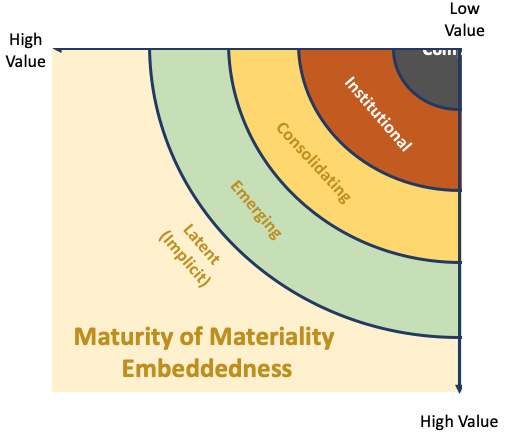
This quadrant seeks to push companies to move away from making decisions from an Institutional mindset where only direct business impacts of the company are prioritized by its operating leaders with no accommodation of non-financial stakeholder viewpoints, to a Latent one, where decision-making is collaboratively identified, shared, and executed upon through a corporate system that has prioritized sustainability measures, enlisted the consent of its stakeholders, set-down clear rules of engagement that define sustainability work and progress, and where standards become habits that build a collective consciousness. Uber operates with an institutional mindset with its “We employee zero automobile drivers” declaration. The company seeks to protect solely its own self-interests. Decisions are made to the exclusion of its stakeholders. Uber’s direct competitor Lyft operates with a Consolidating mindset. The company absolutely knows that its drivers mostly drive combustion-engine cars that emit millions of tons of carbon dioxide into the atmosphere, directly contributing to global warming. So, it takes a Consolidating view: where it can it will support neutralizing its drivers’ carbon emissions through the purchase of one-to-one carbon offsets. Most companies are not going to that length to neutralize their climate carbon contributions. Just as importantly, buying carbon offsets is an acceptable way to build sustainability into one’s operations (albeit, without fundamentally changing one’s way of conducting business).
An Emerging company is one that is taking its sustainability commitments and goals to the next level: not everyone knows about the efforts and presently, only a rare few are pursuing these types of sustainability goals. Think: Interface, the carpet manufacturer. Its “Climate Take Back” sustainability initiative seeks to go beyond having a zero carbon impact on the world and to take-back or sequester carbon already in the atmosphere, through its operations and the carpet tiles it sells and installs. Emerging materiality companies are seeking to solve the world’s most challenging problems.
A Latent-operating company is taking its traditional business model and transforming it to fit the needs of the market while solving for a universal imperative. Signify (formerly Philips Lighting) is one such company. It has committed itself to achieving carbon neutrality by 2020 (end of next year), transitioning to selling only sustainable products (i.e., LED lighting systems), sourcing 100% renewable energy, and achieving full circularity in its manufacturing operations, where waste and materials have revolving value. So too, Signify has committed to solving some of the world’s biggest challenges from regenerative agriculture to solar electrification in support of the UN’s Sustainable Development Goals (SDGs). Latent mindset companies are actively pursuing business transformation; acting as leaders to showcase how it’s done and the over-arching value deeply-embedded sustainability provides.
When you look at this quadrant, ask yourself these questions:
“How transformative are my company’s sustainability goals?”
“How are our pursuits changing the paradigm of how businesses’ operate, manufacture, produce, recycle and support climate change mitigation?”
The Sustainable Value-Creation Matrix
Here’s where we take each of the individual paradigms and coalesce them into a unified matrix on corporate sustainability value-creation.
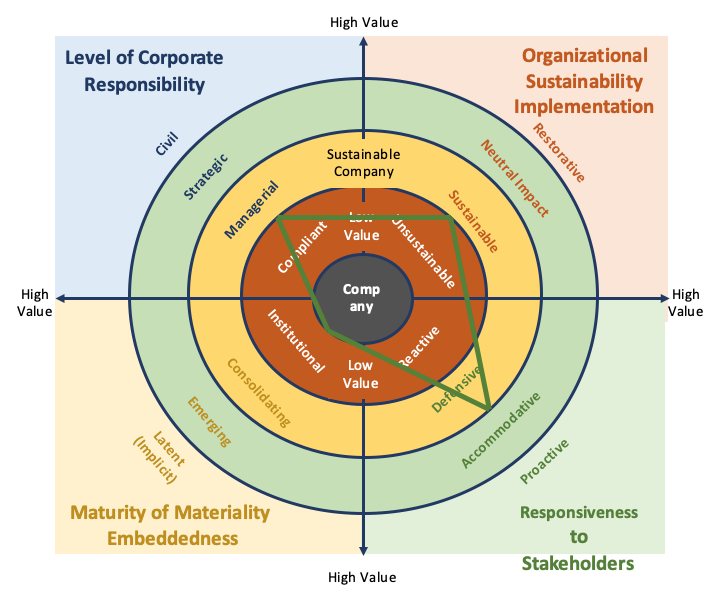
Map your company’s present mind-set on the four concentric circles within the XY axes. Ideally, you should map its existing sustainability expression as well as the future state to be achieved. The goal is to move outward in each of the four quadrant realms: pursuing higher levels of value creation through 1) increasingly proactive stakeholder engagement, 2) greater materiality inclusion into prioritized business goals, 3) sustainability goals that emphasize no or a net-positive impact on the planet and 4) a globally-minded corporate responsibility that is strategically-embedded in business decisions.
At TripleWin Advisory, we help companies execute Stakeholder Interviews and we map organizational value chains to identify prime areas of opportunity to implement sustainability measures that have quick and measurable financial pay-backs. If you are looking for tools to support your company’s Stakeholder engagement work, call or email us to receive a deck with useful frameworks to start the process.
TripleWin Advisory develops sustainable business cases and supports strategic decision-making through value-chain mapping and Scope 3 inventories of companies’ greenhouse gas emissions. In so doing, it unlocks opportunities for greater profitability, relevancy, and longevity for businesses. Learn more.
